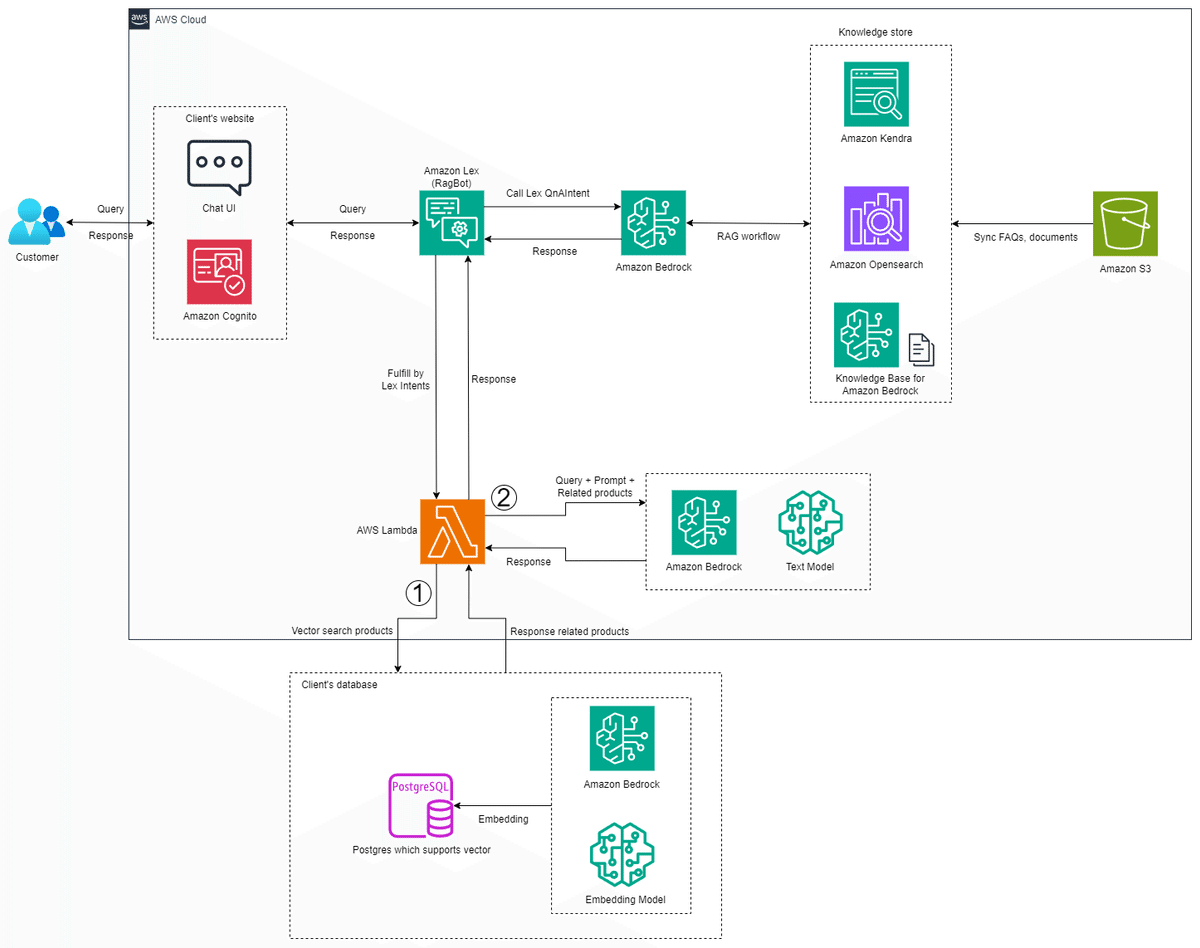
Leveraging AWS Agent AI Bedrock to Enhance Sales and Customer Interaction Channels
Introduction:
In today’s competitive retail landscape, businesses face growing pressure to streamline operations and offer superior customer experiences. One such case involves a retail company specializing in distributing Japanese products in Vietnam. With over 40 retail locations and an expanding online presence through platforms such as Shopee, Facebook, and TikTok, the company sought to enhance its sales channels and automate customer interactions. In collaboration with furuCRM Inc., they aimed to implement an AI-based solution using AWS Agent AI Bedrock to revolutionize customer service and order management.
Challenges:
The company’s current ecosystem consists of various systems, including:
ERP (Microsoft Dynamic Navision): Used for managing products, prices, and orders.
POS (LS Retail): Handles offline sales.
Warehouse Management (SmartLog): Manages inventory.
Groupware (Lark): Facilitates internal communication and file sharing.
Moreover, the company operates multiple online sales channels, including their own app, website, and popular platforms like Shopee and TikTok. The complexity of managing these diverse systems, coupled with a growing customer base, prompted the need for a streamlined, automated solution.
Some of the key challenges were:
Manual Order Processing: Customer orders had to be processed manually, and employees were required to confirm details with customers before completing transactions.
Limited Integration: The systems were not integrated in a way that allowed real-time inventory checks or customer data retrieval during chat interactions.
Inconsistent Customer Service: With multiple communication channels (Zalo, Messenger), there was a need to standardize and improve customer service while reducing the workload of support staff.
Solution: AWS Agent AI Bedrock
By utilizing AWS Agent AI Bedrock, the company sought to automate and improve customer interactions. AWS Bedrock provided the foundation for building a flexible, AI-driven chatbot that could interact with customers, answer product-related queries, and facilitate order placement. Here’s how the solution was implemented:
1. Automated Order Processing and Chatbot Integration:
The first use case involved automating the order process. Customers could interact with the chatbot on platforms like Messenger and Zalo to ask about product availability, prices, and promotions. The chatbot would retrieve real-time data from the ERP system, ensuring accurate information on inventory and prices. Customers could complete their orders by providing details such as product name, quantity, and preferred delivery time.
If a customer requested delivery before 10 PM, the chatbot would send a notification to the relevant store for order fulfillment. For deliveries after 10 PM, the chatbot would adjust the delivery time based on the company’s policies. The system also tracked order statuses and generated reports for employees to follow up on pending deliveries.
2. Data Learning and Personalized Messaging:
The chatbot learned from previous interactions to personalize messages for returning customers. By integrating with the ERP system, it could identify whether a customer had previously purchased from the company, using information such as phone numbers or Messenger IDs. This allowed the chatbot to provide personalized recommendations based on the customer’s order history and preferences.
3. Multi-Channel Integration:
The AWS solution was integrated across several communication platforms, including the company’s website, Zalo, and Messenger. Customers could interact with the chatbot on their preferred platform, and all inputs were routed through a unified interface powered by AWS Lambda. This reduced the workload for customer service representatives, as the chatbot handled basic inquiries and orders.
4. Knowledge Store and Real-Time Search:
To improve the chatbot’s accuracy, the company used Amazon Kendra and OpenSearch to build a knowledge base that included product FAQs, training documents, and other relevant information. This allowed the chatbot to answer more complex questions that went beyond the data stored in the ERP system. The knowledge base was constantly updated with new product information and customer interactions, ensuring that the chatbot’s responses were always up to date.
5. Complaints and Customer Service:
In cases where customers had complaints about products (e.g., damaged goods, wrong item received), the chatbot could pull up order history and initiate the complaint resolution process. For more complex issues, the chatbot would redirect customers to a dedicated support line, ensuring they received timely assistance.
Architecture Overview:

The architecture for this solution is shown in the diagram provided (see attached image). The system integrates various AWS services such as Amazon Lex for the chatbot, AWS Lambda for executing business logic, and Amazon Bedrock for handling product-related queries. The client’s database is connected through PostgreSQL, with vector search support, enabling efficient search capabilities. Additionally, knowledge bases stored in Amazon Kendra and OpenSearch ensure that the system can answer detailed customer inquiries quickly and accurately.
Results:
With AWS Agent AI Bedrock, the company saw several key improvements:
Efficiency: The chatbot automated many routine customer inquiries and order placements, reducing the need for manual intervention. This enabled the company to reduce the number of customer service representatives required for managing online inquiries.
Customer Satisfaction: The AI-driven system ensured customers received timely and accurate information, improving their overall shopping experience.
Scalability: The AWS solution is highly scalable, capable of handling an increasing number of customer interactions across various platforms as the company continues to expand its operations.
Conclusion:
AWS Agent AI Bedrock provided a powerful solution for automating and optimizing customer interactions for the retail company. By integrating multiple systems, including the ERP and chatbot, the company can now provide faster, more accurate responses to customer inquiries while streamlining the order process. This implementation marks a significant step forward in their digital transformation journey, allowing them to keep pace with the evolving needs of their customers and the competitive retail environment.
